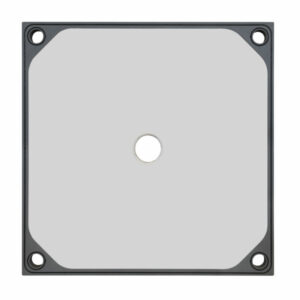Choosing the right filter plate for your application involves considering several factors to ensure that the plate meets your specific requirements.
Here are some important factors to consider when selecting a filter plate:
Filtration requirements: Consider the type of material being filtered and the desired filtration rate to determine the appropriate pore size and configuration for the filter plate.
Chemical compatibility: Ensure that the filter plate material is compatible with the chemical composition of the slurry or liquid being filtered to avoid any chemical reactions or contamination.
Operating conditions: Consider the temperature, pressure, and flow rate of the slurry or liquid being filtered to ensure that the filter plate can withstand the operating conditions without damage or failure.
Plate design and size: Choose a filter plate design and size that is compatible with your filter press and other components. Different designs, such as recessed or membrane plates, may be more suitable for certain applications.
Plate material: Filter plates are made of various materials, including plastic, metal, and composite materials. Choose a material that suits your specific application requirements and offers the necessary durability and chemical resistance.
Cost: Consider the cost of the filter plate and any associated maintenance or replacement costs to ensure that the plate offers good value for money.
When selecting a filter plate, it is important to consult with a trusted supplier or manufacturer who can provide expert guidance on the most suitable plate for your application. Filter plate manufacturer They can help you evaluate your specific requirements and recommend the best filter plate design, material, and configuration for optimal performance and efficiency.
How do I determine the appropriate pore size for my filter plate?
Determining the appropriate pore size for your filter plate depends on several factors, including the type of material being filtered, the desired filtration rate, and the particle size distribution of the solids in the slurry. Here are some general guidelines to help you determine the appropriate pore size for your filter plate:
Consider the particle size distribution: The pore size of the filter plate should be smaller than the size of the particles being filtered. If the particles are too large, they may become trapped in the filter cloth and reduce the filtration efficiency.
Determine the desired filtration rate: The pore size of the filter plate should be selected based on the desired filtration rate. A smaller pore size will result in a slower filtration rate, but may be necessary to achieve the desired level of filtration.
Consider the material being filtered: The pore size of the filter plate should be selected based on the size and shape of the particles in the material being filtered. If the particles are irregular or have a wide size distribution, a larger pore size may be necessary to avoid clogging.
Consult with a filter plate supplier: A trusted filter plate supplier or manufacturer can provide expert guidance on the most suitable pore size for your specific application. They can help you evaluate your specific requirements and recommend the best pore size for optimal performance and efficiency.
It is important to note that the appropriate pore size for your filter plate may also depend on the type of filter press being used and the configuration of the filter plates. Consult with a filter plate supplier or manufacturer to ensure that you select the best filter plate for your specific application.
